Menus
- Fast and relaxed entry-level bike
- Consumption and range
- Power transmission
- Chassis of the Moto Guzzi V7 III
- Braking performance of the Moto Guzzi V7 III
- Conclusion from the top test
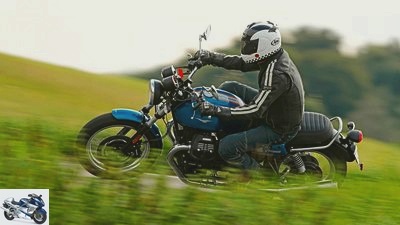
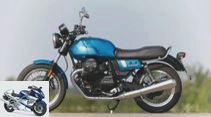

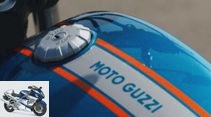
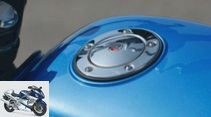
12th photos
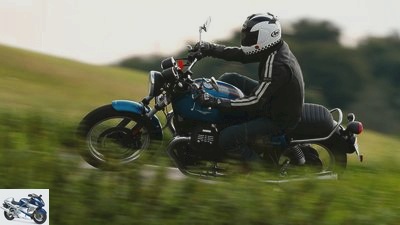
1/12
The number three plays an extremely important role in our culture. The developers of Moto Guzzi could not escape their power either and have just given the third edition of their V7 profound innovations.
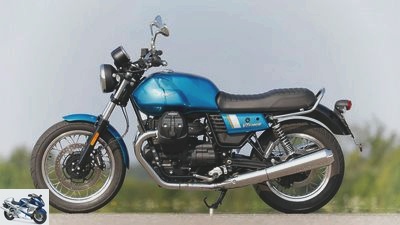
2/12
The tank design of the V7 II looks better, but in most other points the three offers noticeable progress.
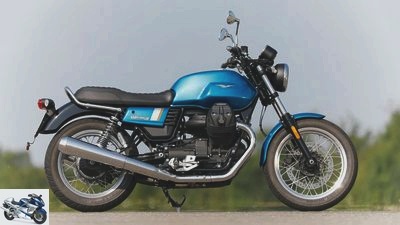
3/12
The new double-walled elbows look pretty powerful, but their inner diameter has not changed.
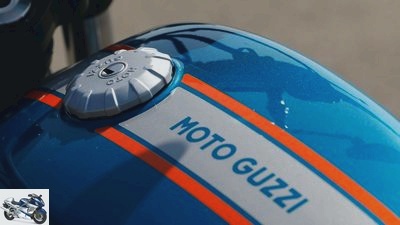
4/12
Saving measure 1: The fuel filler cap of the new V7 is made of metal, but looks like a plastic part and is no longer countersunk.
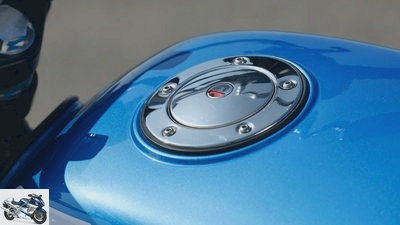
5/12
Noble and practical: chrome-plated and embedded in the tank surface,
the tank cap of the V7 II is more elegant and valuable than that of the V7 III.
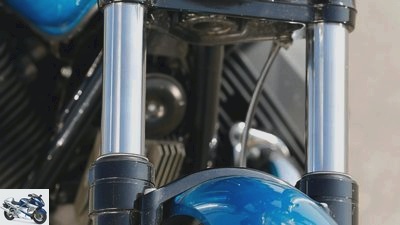
6/12
Saving measure 2: With the V7 III, the stanchions of the conventional fork are unprotected from the dirt thrown in the airstream.
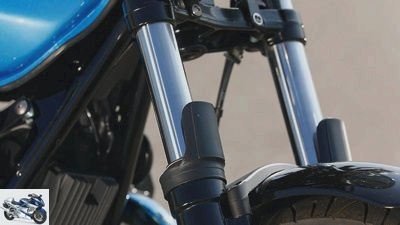
7/12
Small but effective: the V7 II has deflectors on its fork. In driving-
compressed during operation, more than half of the spring area is protected.
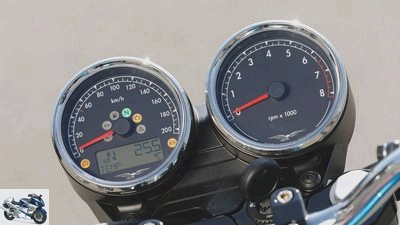
8/12
The instruments got a new scale design and a larger digital display. Your information has to be called up one after the other.
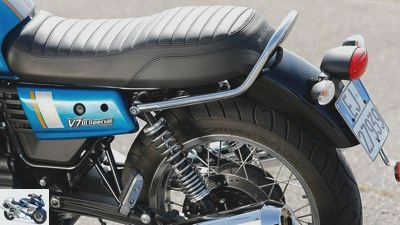
9/12
Six innovations can be seen here: indicators, retaining brackets, strut, side cover, silencer and the rim in natural aluminum.
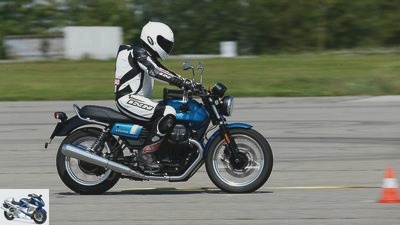
10/12
The steering head is now one degree steeper, the wheelbase has been lengthened by one centimeter, the suspension struts are shorter and steeper.
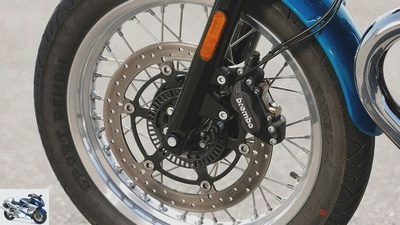
11/12
A 320 mm disc at the front and the powerful four-piston caliper from Brembo decelerate the V7 brilliantly.
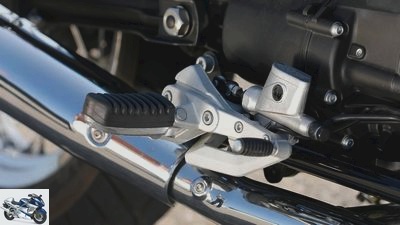
12/12
New footrest holders integrate the operation of the rear brake and the shift linkage on the left.
Moto Guzzi V7 III Special in the top test
Fast and relaxed entry-level bike
The current entry-level series at Moto Guzzi stops under the traditional model name V7 and is now available in its third edition – with far-reaching changes compared to its predecessors. MOTORRAD put the Moto Guzzi V7 III Special through its paces in the top test.
The first appeared exactly 50 years ago M.oto Guzzi V7. A lot has happened recently with the current V7 series: The V2 engines got modern pistons and cylinder heads with correct combustion chambers. So far, pistons and cylinder heads were designed according to the Heron principle, i. H. the mixture burned in deep hollows in the piston crown. This was considered to be cost-effective and economical – at the expense of maximum performance.
Buy complete article

Moto Guzzi V7 III Special in the top test
Fast and relaxed entry-level bike
More power + nice torque curve
Beyond the symbolic value, the changes to the Moto Guzzi V7 III bring tangible technical advantages: more power, for example – as the MOTORRAD test bench proves, even 2 hp more than indicated. In addition, a voluminous torque curve arches over the speed axis.
In combination with the smaller, albeit still stately, flywheel mass and the lighter pistons, there is a pleasant combination of full blow and noticeably increased revving. Even in sixth gear, the V2 engine happily cranks into the red area, which starts at 6,500 rpm; the top speed of the Moto Guzzi V7 III should in reality even be slightly above the specified 170 km / h, even taking into account the fact that the speedometer greatly exaggerates.
Of course, you don’t buy a Moto Guzzi V7 III to drive at a consistently high speed on the autobahn – but it could. The 744 does not develop too much braking torque when braking before bends and when turning in, and starts to accelerate gently from the middle of the bend, but without noticeable delay. This helps when driving relaxed country roads, if desired also when driving briskly.
Consumption and range
Nevertheless, the Moto Guzzi V7 III does not consume more fuel than its predecessor: the injection did not spray more than 4 liters per 100 kilometers into the combustion chambers during the consumption lap, while on the motorway at a constant 130 km / h it remained at 4.1 liters per 100 Kilometre. In sixth gear, the engine rotates around 4,900 rpm, which is at least on the threshold of the upper speed range. That speaks for a very efficient combustion.
The 21-liter tank will therefore last more than 300 kilometers, even with a high-performance driving style. The driver has to ignore the reserve warning, which lights up early, for a long time. During the test drives with the Moto Guzzi V7 III there were almost 5 liters of petrol in the tank shortly after the warning signal came on.
Power transmission
The small dip in the torque curve around the 4,000 mark indicates the area in which the modernized engine of the Moto Guzzi V7 III vibrates the most under load. Above and below, the mechanics are more noticeable in the form of a not unpleasant pulsation, they show the smooth running that one expects from a Guzzi. In contrast, the six-speed transmission of the test machine behaved much less rustic than expected. It can be shifted easily, precisely and quietly; Moto Guzzi would not be completely silent. Only sometimes does the driver have to shift back and forth between first and second gear in order to find neutral. However, this is due to the slight, almost invisible locking of the gear wheel pairs and not – as in motorcycles with oil bath clutches – to sticking friction discs. What should the washer of a dry clutch stick to??
The transmission of the Moto Guzzi V7 III is identical to that of the V9, but not the final drive. It is more delicate. Does it have anything to do with the fact that the V7 produces a much quieter running noise? Whatever the case, the grinding of the angular gear is always audible until the wind noise prevails at higher speeds, but it doesn’t sound as penetrating as it did with one or the other V9 test machine.
Chassis of the Moto Guzzi V7 III
In the course of the revision, the third edition of the Moto Guzzi V7 got a modified chassis; the steering head is now one degree steeper, the wheelbase has been lengthened by one centimeter, the suspension struts are shorter and are also steeper. As a result, the rear suspension travel is reduced from 118 to 93 millimeters. With this measure, Moto Guzzi has not achieved any improvement, neither in terms of driving dynamics nor in terms of comfort. The suspension struts should respond better now, but on the bumps on German country roads and highways, the rear wheel suspension quickly reaches the end of the spring travel or in strong progression, and then the rear tire is crunched heavily. This brings noticeable steering torque, and precision suffers as a result.
With longer struts and longer suspension travel, this whole chassis complex could be improved and the tight lean angle of the Moto Guzzi V7 III increased. Quite apart from the fact that the driver’s back would then have to take less pithy bumps.
The weakness of the hindquarters need not scare anyone interested in the Guzzi; the chassis reactions are not dangerous. But they stand out because you can hardly defend yourself against them. The seating position on the Moto Guzzi V7 III is a bit too casual, the bench, which has been lowered to 770 millimeters, is a bit too deep, and the footrests are mounted too far forward.
Braking performance of the Moto Guzzi V7 III
However, there is also an advantage associated with the low seating position, which increases the weight distribution, which is heavy at the rear: The Moto Guzzi V7 III enables brilliant braking maneuvers. Although the front wheel only has one brake disc, an average deceleration of almost 1 g, i.e. 9.81 m / s², can be achieved from 100 km / h. Nice to dose, thanks to the heavy stern very stable course and reliably moderated by ABS. In emergency situations, the Guzzi offers a reassuring measure of active safety. The prerequisite for this, however, is that the driver supports himself against the forces that he generates during such a braking maneuver. Occasional training is recommended in order not to be surprised by the severe delay that the Moto Guzzi V7 III can incur in an emergency.
Compared to the Conti-ABS, the two-stage traction control for driving on dry asphalt is too defensive. Even at the sharp level 1, it already intervenes at a brisk traffic light start if no tire slip is noticeable for a long time. Apparently, the sheer acceleration is enough to call the system to work. On a dry track, you can easily switch off the traction control of the Moto Guzzi V7 III, while level 1 offers sufficient safety for driving in the rain.
Conclusion from the top test
The Moto Guzzi V7 III has become a better bike than its predecessors, largely thanks to the new engine and brakes. Because of the tight rear suspension travel, the chassis is less convincing, but ultimately the easy curve swing of the Guzzi won the sympathy of the testers. The price is quite high for a simple motorcycle with just over 50 hp.
Related articles
-
Driving report Moto Guzzi California Special and Quota 1100 ES
Driving report Moto Guzzi California Special and Quota 1100 ES Magical power Forza in movimento – there is power in movement: The Moto Guzzi eagle should…
-
Top test Moto Guzzi Stelvio 1200 4V
Bilski 10 photos Moto Guzzi 1/10 Moto Guzzi 2/10 Moto Guzzi 3/10 Moto Guzzi 4/10 Moto Guzzi 5/10 Moto Guzzi 6/10 Moto Guzzi 7/10 Moto Guzzi 8/10 Moto…
-
fact Test Moto Guzzi MGS-01 Corsa Please copy it! Moto Guzzi dealer Hokenschnieder has done it: He is bringing the racing Guzzi MGS-01 Corsa onto the…
-
Tourer comparison test Moto Guzzi Norge and BMW R RT
fact Tourer comparison test Moto Guzzi Norge and BMW R RT End of the line sea addiction Come on: on a cruise from the Staffelsee via Lake Como to Lake…
-
Comparison test of the BMW R 1200 C against Moto Guzzi California Special
Comparison test of the BMW R 1200 C against Moto Guzzi California Special Car pool With all the urge to present yourself: Euro cruisers like the R 1200 C…
-
Benelli, Buell, Moto Guzzi and Moto Morini
Moto Morini 6th photos Moto Morini 1/6 The Moto Morini Granpasso 1200 is clearly aimed at BMW. Moto Morini 2/6 The Moto Morini Granpasso 1200 is clearly…
-
Bilski Test Moto Guzzi Norge 1200 GT Velvet instead of special With the Norge, Moto Guzzi finally says goodbye to the image of the coarse racing cars….
-
Harley-Davidson Fat Boy S and Moto Guzzi California Custom put to the test
markus-jahn.com 22nd photos markus-jahn.com 1/22 I’m a Celebrity, Get Me Out of Here? Oh no. Harley-Davidson Fat Boy S and Moto Guzzi California Custom…
-
Top test Moto Guzzi 1200 Sport 4V
fact Top test, Moto Guzzi 1200 Sport Moto Guzzi 1200 Sport 4V Moto Guzzi hasn’t just been in crisis since the crisis. In the identity crisis. Classic or…
-
35 photos 1/35 Photo gallery: Triumph Bonneville T100 Black, Moto Guzzi V9 Roamer and Harley-Davidson Sportster 883 Iron in a…